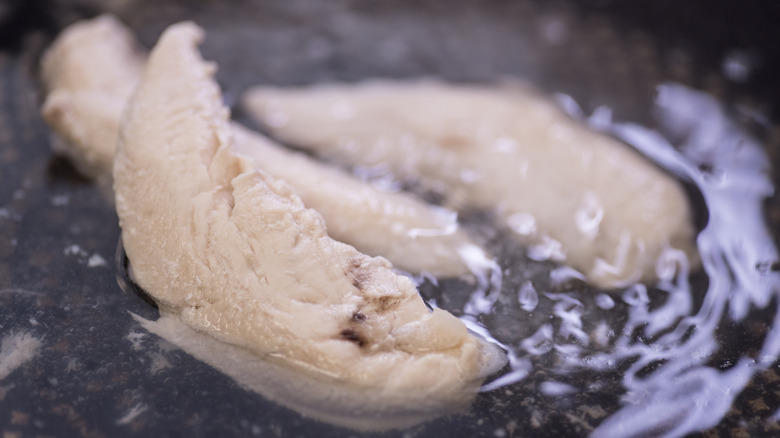The Poached Chicken Myth You Should Stop Believing
Although poaching remains to be one of the least preferred methods of cooking, there are a surplus of reasons why cooking poultry in this way is actually a smart idea. Totally effortless; all you need to do is cover chicken pieces in liquid, letting them simmer on the stove until fully cooked. An essentially fat-free cooking process (poaching liquid, depending), the other advantage is that meat stays tender — or is this just a long-perpetuated myth?
Diet or not, poached chicken does have a place in all sorts of recipes. Because a simmer in water can render the meat fairly neutral in taste, it can be the perfect addition to richly flavored soups, condiment-ladden sandwich fillings, or a fully-loaded casserole. However, even when shredded, poached chicken can be the star of salads or tacos when the poaching liquid is properly seasoned. Working with liquids like stock, wine, coconut milk, or oil can do wonders, much like the addition of any aromatics, herbs, or citrus zest.
However, what makes poached chicken especially unique is that, unlike boiling, poaching is a much more delicate process carried out at a lower temperature and over a more extended period of time. While even boiling is a moist heat cooking method, poaching is typically branded as the foolproof process to ensure chicken never dries out. Whether or not there's any truth to this is up for debate.
Believe it or not, poached chicken can still become dry
More often than not, many agree that poaching is the best way to guarantee that chicken stays juicy. However, if you're under this impression, you'd be mistaken.
While it's true that poaching is a gentler cooking technique that prevents the meat from seizing up like it would when faced with a flash of high heat, that doesn't mean that there isn't still a risk in overcooking the chicken. Rather than end up with rubbery or dry poultry, it's important to pay attention to time and temperature – poaching is all about cooking low and slow.
In addition to starting with a cold poaching liquid, allowing the meat enough time to cook is necessary. While it could take anywhere from 15 minutes to an hour, depending on the cut, the size of the pot, and the warmth of the poaching liquid, it's best to use a thermometer to determine when the meat has finished cooking.
Once the thickest part of the poultry piece reads 150 degrees Fahrenheit, pull it from the liquid and allow it to rest for several minutes so that juices can be redistributed for maximum moisture and a string-free result. So the next time you make poached chicken, don't be fooled into thinking it's a foolproof method — just let it take its time to cook thoroughly and become tender and juicy.

